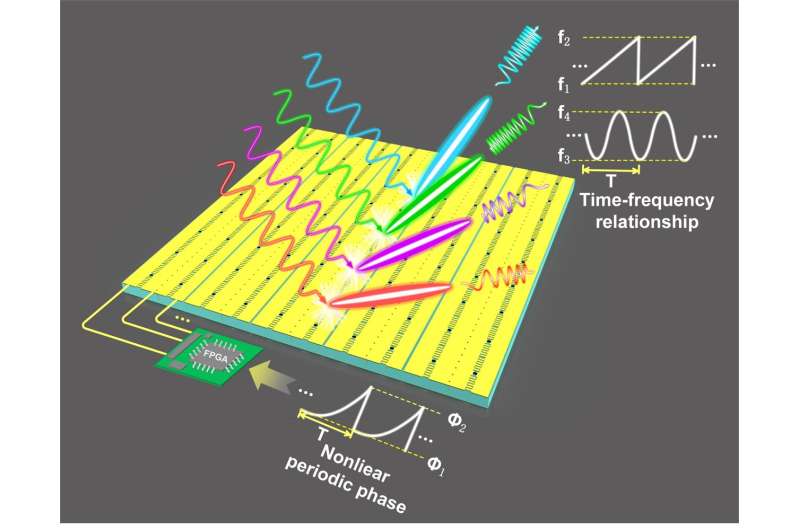Frequency-modulated continuous waves controlled by space-time-coding metasurface with nonlinearly periodic phases

Pulse compression is an important technology in modern radar systems and promotes the developments of modern radar technologies towards higher speed and ranging accuracy. The frequency-modulated continuous wave (FMCW) signals, with the advantages of large time width and large bandwidth, become the typical pulse compression signals.
However, the FMCW signals are mainly generated by the voltage-controlled oscillators (VCOs) or direct digital synthesis (DDS) technologies, causing high system complexity and integration difficulty with the antenna modules. Therefore, one of the important questions for researchers is how to design a low-cost and high-efficiency FMCW signal generation method.
In a new paper published in Light: Science & Applications, a team of scientists, led by Professors Qiang Cheng and Tie Jun Cui from the State Key Laboratory of Millimeter Waves and Institute of Electromagnetic Space, Southeast University, China, and co-workers have developed a theoretical framework and method to generate FMCWs and control their spatial propagation behaviors simultaneously via a novel STCM with nonlinearly periodic phases.
The research team designed a reflection-type STCM with 360-degree full-phase coverage. When it was biased by the nonlinear periodic voltage control signals, the nonlinear periodic phase responses can be obtained and modulated onto the incident electromagnetic (EM) waves immediately. In this way, the FMCW signals with time-varying instantaneous frequencies can be synthetized.
The time-frequency characteristics of FMCW signals based on the STCM are closely related to nonlinear periodic voltage control signals. By programming the control signals, different types of FMCW signals can be synthesized on the same STCM on demand.
In addition, by optimizing the initial voltage distributions among different regions of the metasurface, additional phase gradients can be introduced into the metasurface, and then the propagation directions of the FMCW beams can be manipulated. The reported method will lay the foundation for novel signal pulse compression technologies. The scientists summarize the operational principle of this work:
"We design a method to generate FMCWs and control their spatial propagation behaviors simultaneously for two purposes in one: (1) to synthesize the FMCW signals by designing the required nonlinear periodic voltage control signals; and (2) to manipulate the propagation directions of the FMCW beams by optimizing the initial voltage distributions among different regions of the metasurface."
"Compared to the traditional FMCW signal generation method, the proposed method does not need the frequency synthesis and phased-array antenna modules, which can effectively reduce the cost and complexity," the scientists say.
More information: Jun Chen Ke et al, Frequency-modulated continuous waves controlled by space-time-coding metasurface with nonlinearly periodic phases, Light: Science & Applications (2022).
Journal information: Light: Science & Applications
Provided by Chinese Academy of Sciences




















